watalappan(watalappam) a traditional Sri Lankan dessert that has a luscious and creamy texture and can be compared to a custard or flan
Here’s my grandmother’s authentic family recipe that helps you to make this dessert in the most authentic way.
The beauty of Watalappan lies in its simplicity.
The recipe is made with a handful of basic ingredients, each bringing in its own unique flavour.
And to those of you who are not familiar with the term “watalappan”, well it’s a traditional Sri Lankan dessert that is made by Muslims(moors)in Sri Lanka for festivals and special occasions.
Watalappan(watalappam)is basically a steamed coconut milk and jaggery custard pudding.
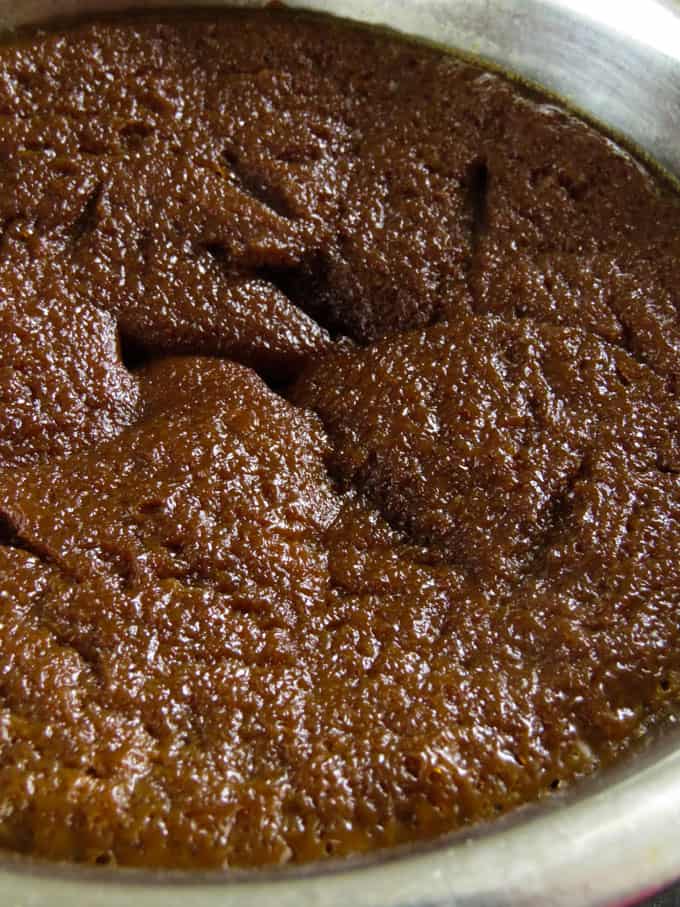
Who doesn’t love a bowl of watalappan?
It’s what the neighbours next door or co-workers expect from their Muslim friends.
And they are never shy about asking for a bowl of this rich, dark-sweet dessert made with Jaggery(palm sugar), coconut milk, and eggs.
Who can blame them?
A bowl of watalappan is too good to miss out and if you’ve had a slice of this steamed custard pudding you’ll know why.
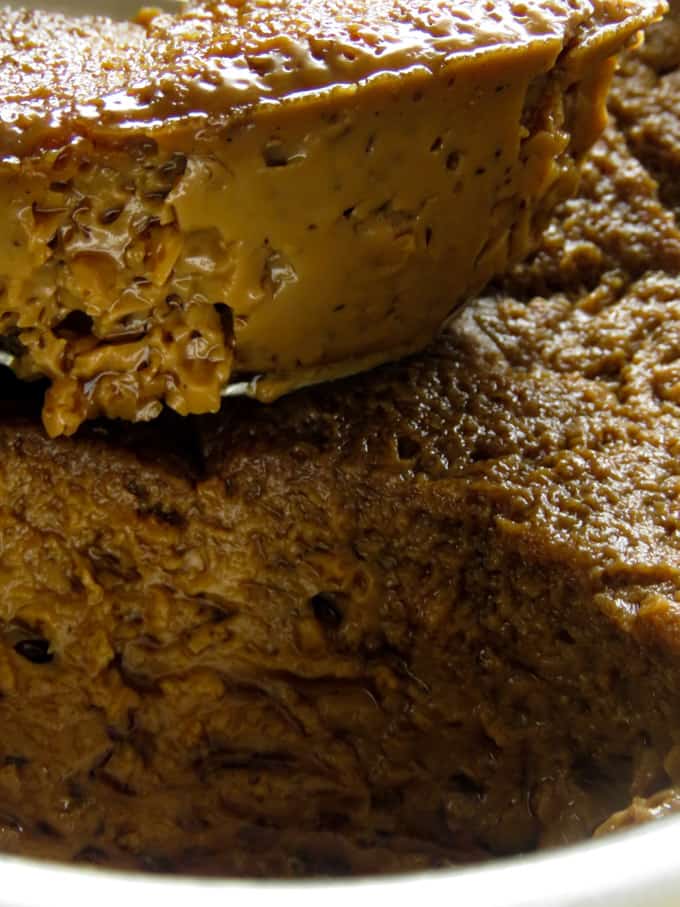
Savoring Watalappan, “my sweet Memories”
I grew up in a house where making watalappam for the festival was never confined to 5-10 cups, more like 25 or sometimes more.
Eggs, eggs, and more eggs were broken into large cooking pans, melting huge amounts of good quality kithul hakuru(jaggery, palm sugar), beating up these two ingredients, and then pouring them into bowls.
These large aluminium bowls filled with the watalappam mixture were steamed outdoors over a massive cooking pot to accommodate and batch steam.
Each year the number of bowls increased and the ingredients needed were recalculated and then bought.
My grandmother wanted only the best quality Jaggery which she only bought from one particular place and she had almost all the ladies in the house working under her.
It took a whole day for this whole watalappan making business to be done and dusted.
Memories like moving picture postcards where I see myself whisking a large pot of eggs and jaggery syrup, blooms of smoke outside where a large aluminium pot held two layers of bowls, huddled conversations, mixed with laughter and then some scolding from the matriarch of the family.
But writing about these memories will only delay you from getting your watalappam recipe so let’s move on, shall we?
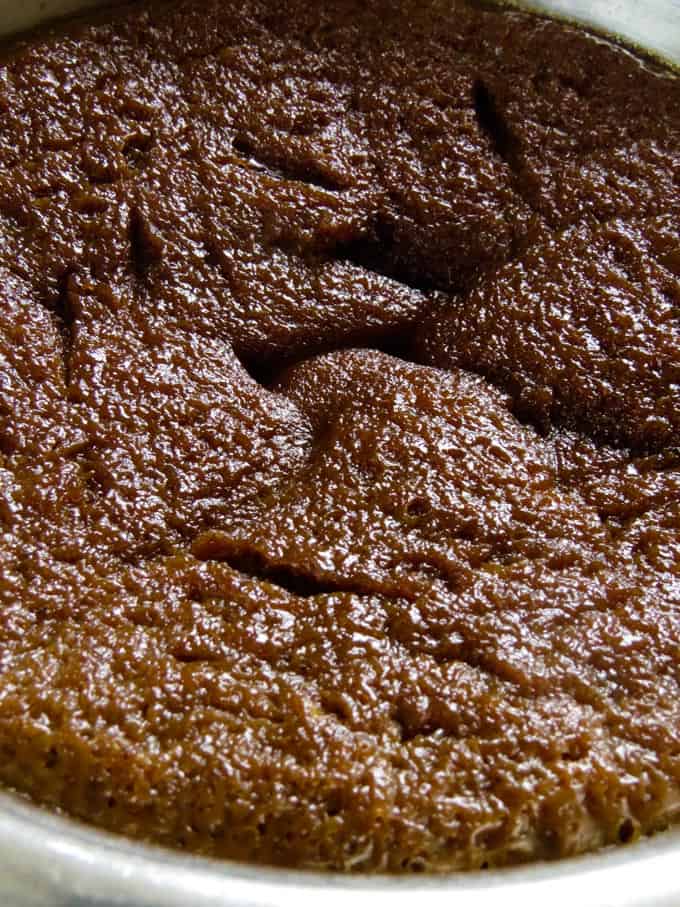
PRESERVING THE AUTHENTIC WATALAPPAN RECIPE
Times have changed.
It’s getting harder and more expensive to buy good jaggery.
People have found much easier ways to make the steamed custard pudding.
It’s inevitable that as time goes by everyone adapts to the new ways of making this dish(baking it, substituting ingredients, etc.).
At some point, a whole new generation will have no idea that the watalappan in its authentic form,
- Was steamed.
- Made with certain whole spices, jaggery, coconut milk and eggs, the steamed pudding has a honeycomb-like appearance with a taste that is unique as well.
- Was not made in Pyrex dishes.
- No vanilla was used.
- Nor was condensed milk used.
This traditional Muslim dessert was served with two bananas placed on top of the steamed pudding(no one does this anymore do they?).
Save the recipe to Pinterest
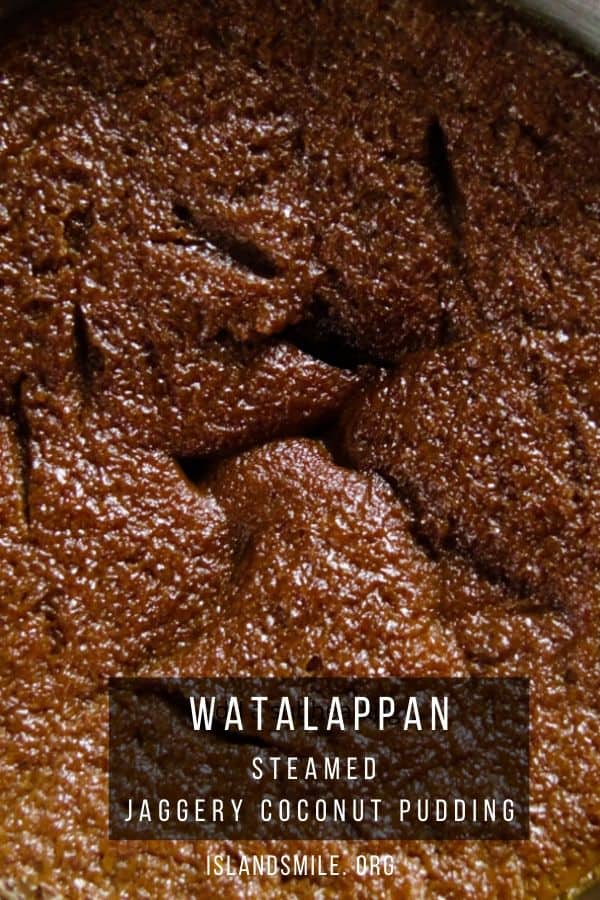
Utensils and appliances needed
- Large, thin-bottomed cooking pan with a tight lid
- A piece of cotton cloth to tie over the lid of the pan
- A medium-sized pan to melt Jaggery
- A medium-sized bowl to whisk the eggs
- whisk, fork, wooden spoon, large strainer
- A large jug or measuring jug to strain the watalappam mixture into.
- Aluminum bowls (4″-5″ in diameter)
Tips on making this watalappan recipe
- Have all the ingredients ready before you begin making this dish.
- Always buy good quality jaggery. this is one ingredient that should be measured in weight than cups. so I have given the quantity in grams.
- Coconut milk– use the liquid form and not powdered coconut milk.
- The pan you will use as a steamer- depending on the type of pan you will use as a steamer, the cooking time will increase or decrease.
- A thin-bottomed pan(an aluminium pan), the required time needed to steam reduces.
- A heavy-bottomed pan, meaning the bottom of the pan is thicker than the sides of the pan, the cooking time will increase.
- Covering the lid with a piece of thick cloth is vital in keeping any drops of condensation falling into the bowl, diluting the jaggery-coconut milk-egg mixture.
- Add the correct amount of water to steam the watalappam and make sure there is always adequate water as you steam a new bowl.
- Make sure that no steam escapes the pan(very important).
- Once a watalappan bowl is done, switch off the fire.
- let the steam reduce and wear a thick mitten to remove the bowl from the hot steaming pan to avoid your knuckles burning as you lift the cup and come into direct contact with steam.
- Before you take your first spoon of watalappan, let it cool, refrigerate (cover with cling film)and leave it for a day.
Trust me, the jaggery pudding taste way better this way.
- How to serve-take the watalappam out from the fridge, scoop a few tablespoons of it on to a bowl, cut a few slices of banana over it, and enjoy.
Troubleshooting your watalappan recipe
- Pretty on the outside, watery inside.
Here are a few reasons your steamed watalappam may be watery, meaning it looks cooked but when sliced into, it’s still not set.
- Not enough eggs.
- Check if steam is escaping from the pot.
- Less cooking time used depending on the type of steaming pan you’ve used(read beginners notes).
- Using larger bowls than the recommended size. larger bowls need more time to cook.
- Once steamed, why does my watalappan mixture look lighter in colour and not the dark, rich colour you expect it to be?
This is due to the type of Jaggery you use.
As I said good quality Jaggery is hard to find, many mix sugar into it.
There are two ways to solve it.
1/simply use a few drops(1-2)of brown colouring (cringing as I give you this solution but it’s the easiest cheats way).
2/caremelize 2 tablespoons of sugar with 4 tablespoons of water over low fire until you get the dark amber colour and add to the Jaggery mixture.
If you are using this method, make sure you avoid caramelizing the sugar too much and turning it bitter.
More Sri Lankan sweet desserts
Condensed milk fudge(milk toffee)
Fluffy pineapple pudding with condensed milk
How this watalappan recipe is written
Certain recipes need to be preserved as they are while finding new ways to adapt the recipe as well.
I have NOT written this recipe, the conventional way. This recipe includes,
- The original and authentic recipe as made by my grandmother and mom.
- I have also tested other ways of making this dessert and its outcome.
By this I mean, different cooking methods like steam which the original recipe calls for, and then baking and pressure cooking, other methods will be added as time permits.
- I’ve also taste-tested them for you and noted down the differences in appearance and flavor, using the above methods of cooking.
- At the time of writing this authentic watalappan recipe(April 2020). I have not substituted any ingredients to make a hybrid version.
By hybrid I mean, quick versions where there are substitute ingredients(condensed milk, pumpkin, store-bought jaggery syrup)but only experimented with the method of cooking.
I will do this in time and add it here as time permits.
For now, let’s begin with the original recipe.
Please make sure to read the recipe instructions carefully to avoid mistakes.
RECIPE DIFFICULTY-more CARE NEEDED
The ingredients mentioned below use standard measuring cups and spoons.
This recipe will give you 3 bowls of watalappam. the bowls used here are 4″ to 5″ in diameter.
Ingredients
10 eggs
500g Jaggery(broken into smaller pieces)
1/4 cup water
1/2 teaspoon of lime
500ml thick coconut milk(2 cups, this is not coconut cream)
The fragrant whole-spice mix
8 slightly bruised cardamom
1/2 teaspoon of grated nutmeg
2-inch Pandan leaf
How to make Watalappan
Before you begin making the watalappam, you first need to have a thin bottomed, deep cooking pot with a tight lid.
This pan should also be wide enough that, removing the steamed jaggery pudding can be done without burning yourself.
preparing the steaming pan
The lid needs to be covered with a thick cloth first.
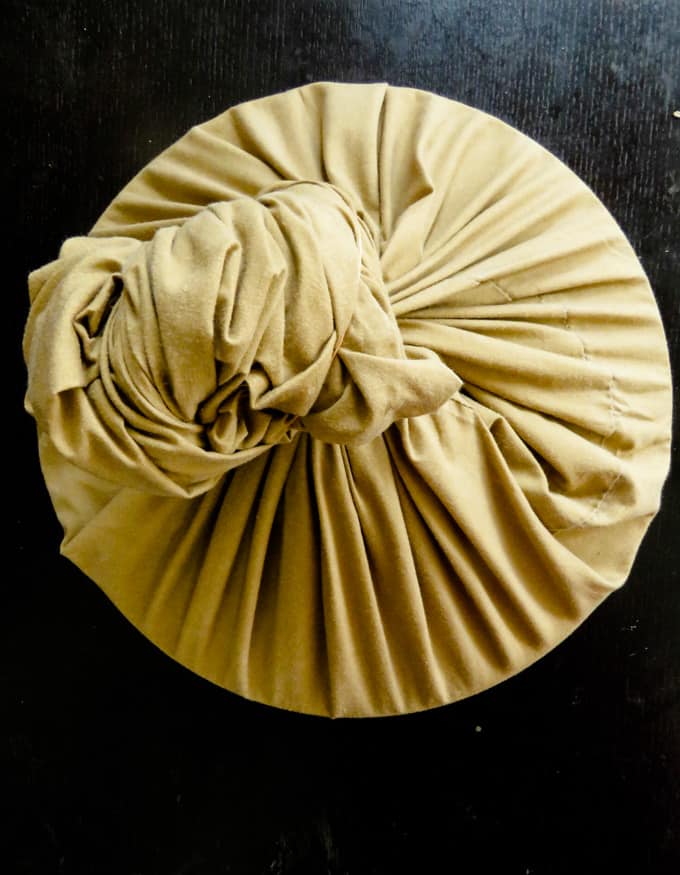
The cloth surface that is going to be placed over the pan facing inside should be stretched and tight.
The covered lid helps to stop any steam from escaping while the watalappam cooks.
The cloth will also capture the condensation that builds on the lid which can spill and ruin the watalappam.
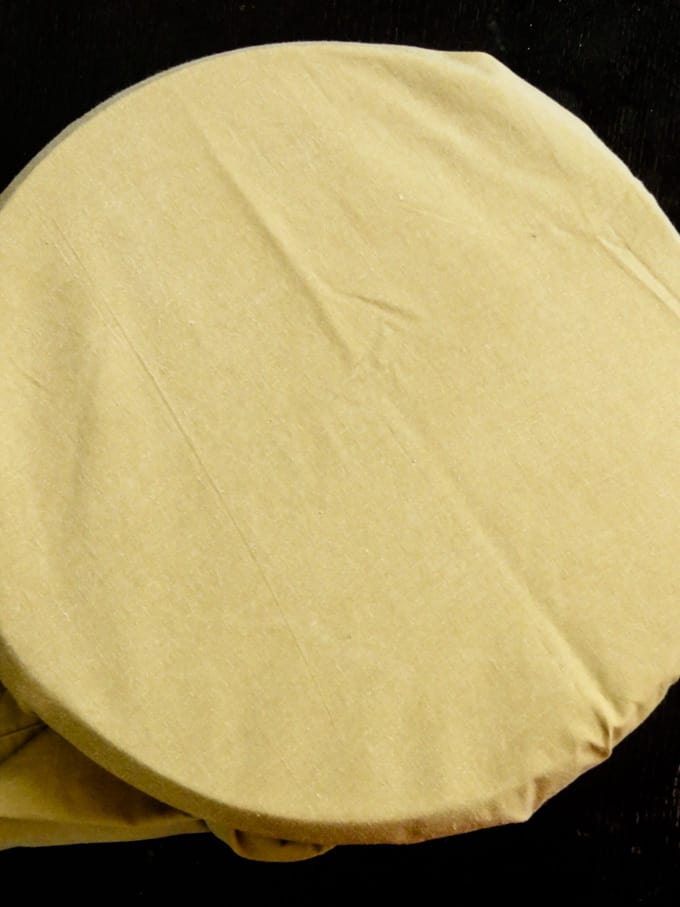
Once you’ve prepared the pan to steam the pudding, it should look as below. set aside until used.
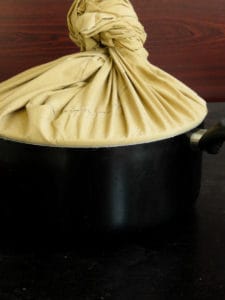
How to melt the Jaggery
Use a medium-sized pan.
Add water(1/4 cup) and Jaggery(500g). The melting process would be easier if you break the hard jaggery into smaller pieces.
Avoid adding more water as you want the Jaggery to be really thick, giving you a heavy and dark syrup.
Maintaining low heat, melt the jaggery while stirring it every few minutes, make sure the thick syrup does not stick to the pan by keeping the flame as low as possible.
Once the jaggery melts, remove it from the stove and set it aside to cool.
Jaggery tends to harden as it cools, to avoid this add lime juice(1 tsp)and stir a few times.
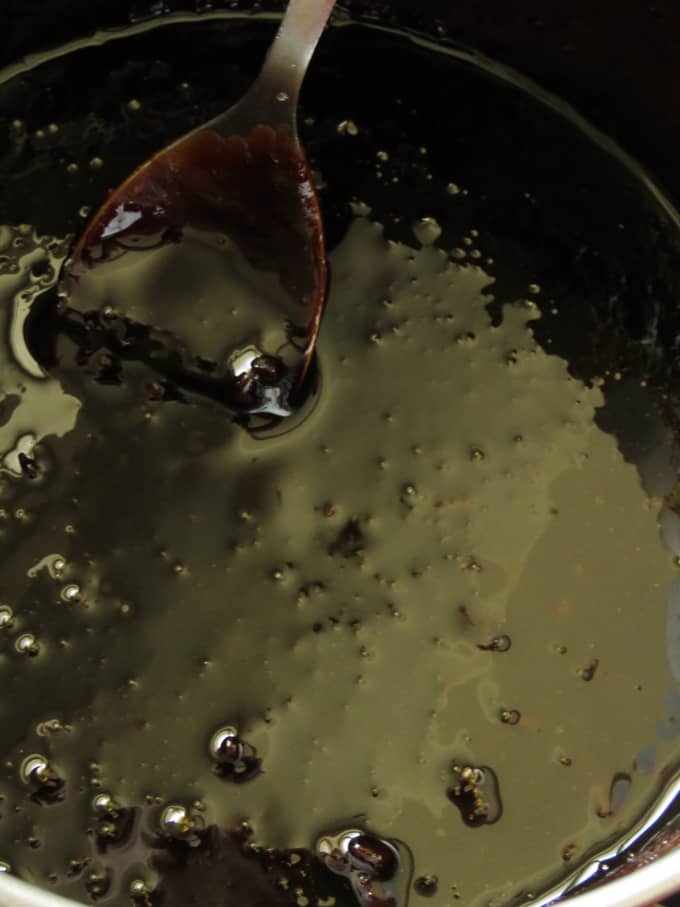
Have your whole spices ready( 8 cardamom-bruised, 1/2 tsp grated nutmeg, 2-inch pandan leaf).
If you are unable to find the following spices use Vanilla essence(1 teaspoon).
But please do try using the whole spices and experience the taste difference at least once.
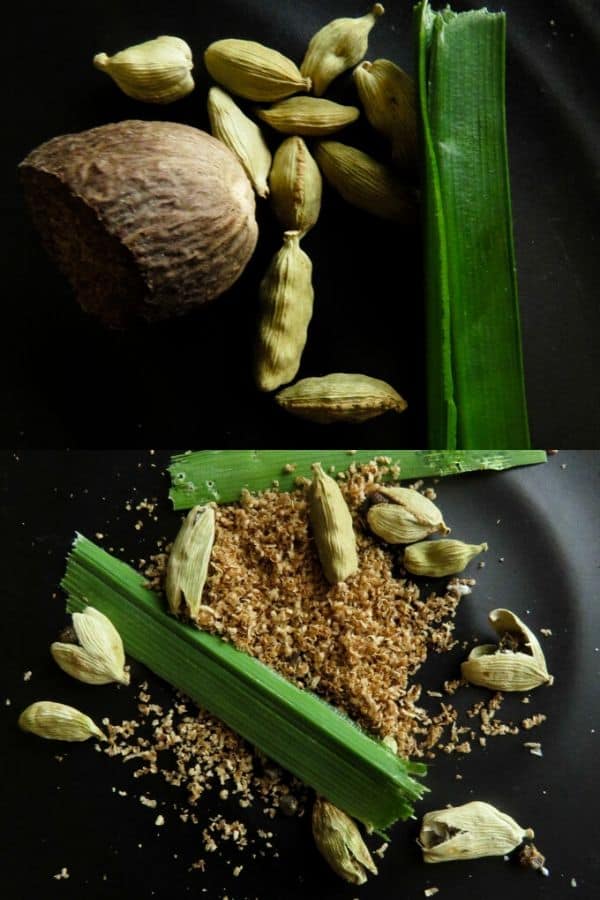
making the egg custard mixture
Break the eggs(10), one by one into a small bowl to check freshness, and then add them into a medium-sized bowl or pan.
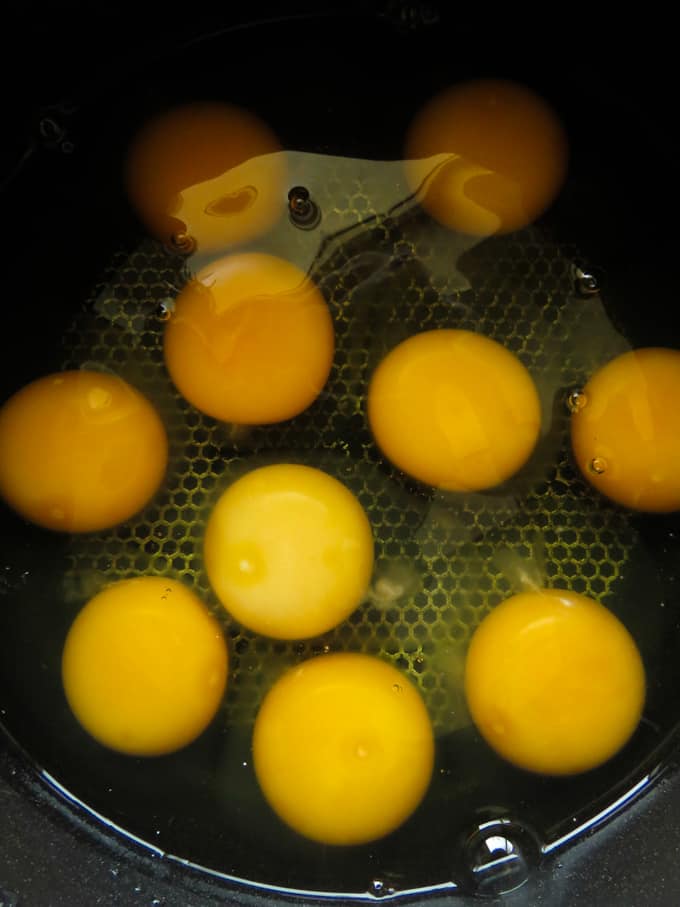
Add the whole spices and pandan leaf to the egg mixture.
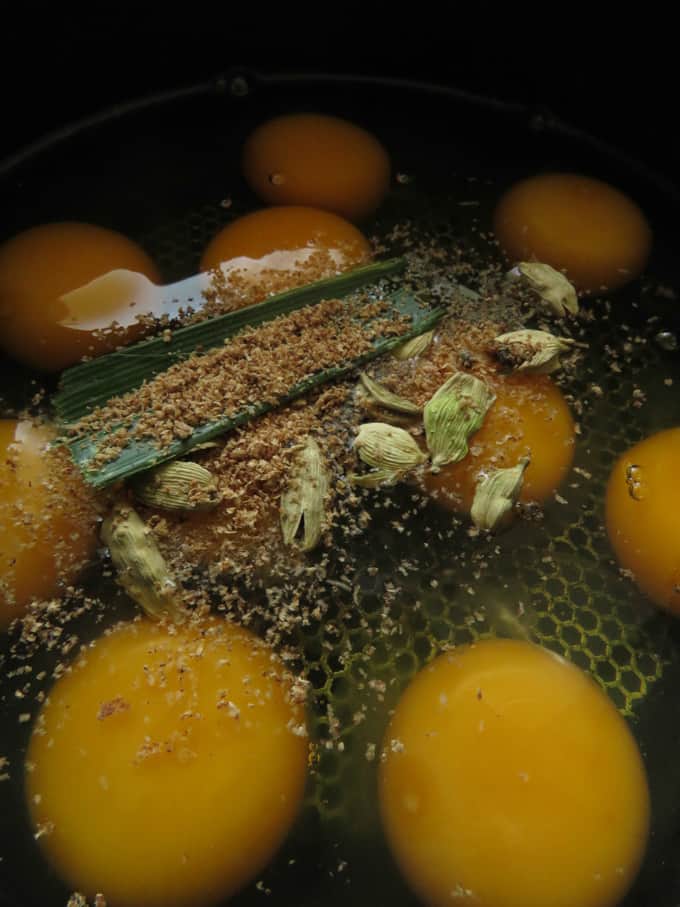
Whisk lightly until the egg yolks are broken for 3-5 minutes.
Avoid whisking vigorously. keep your movements light by making sure your whisk is not hitting the bottom of the egg mixture bowl.
If you are making a large batch of watalappam, this can be done with a handheld mixer.
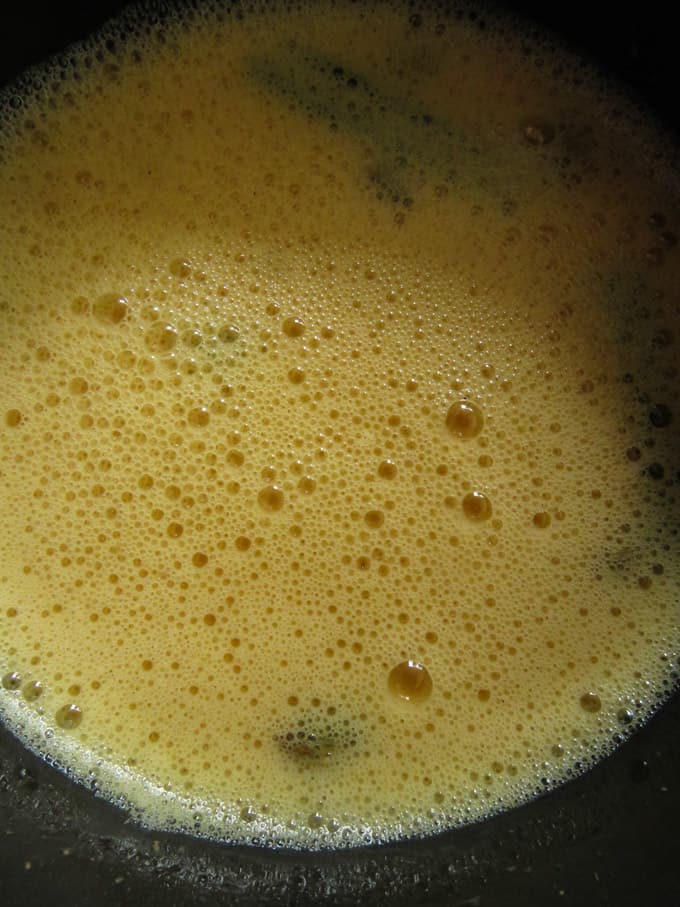
Once you have beaten the eggs, set this aside for a few seconds and go back to your COOL melted jaggery.
Stir the Jaggery a little, the jaggery syrup should be completely cool.
And only then add the egg mixture to the Jaggery syrup.
Stir to combine the Jaggery with the whisked eggs.
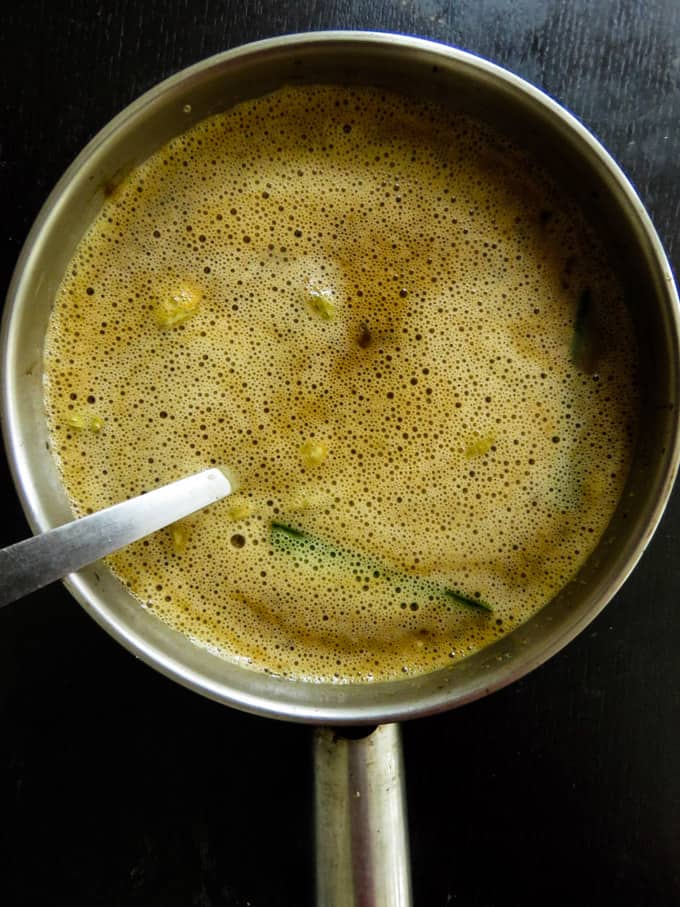
Finally, add the thick coconut milk(500g=roughly 2 cups of liquid) to the egg and jaggery syrup.
Use a whisk or fork to lightly beat the watalappam mixture for 3-5 minutes(I did it for 5 minutes).
Again keep your movements light and avoid the whisk or fork hitting the bottom of the pan.
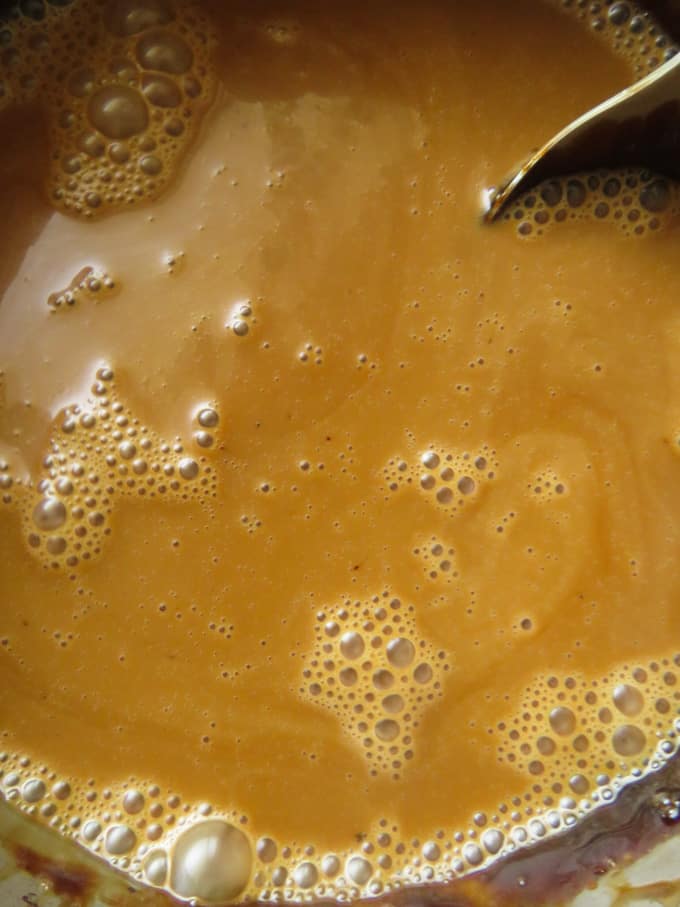
Have a large jug and strainer ready.
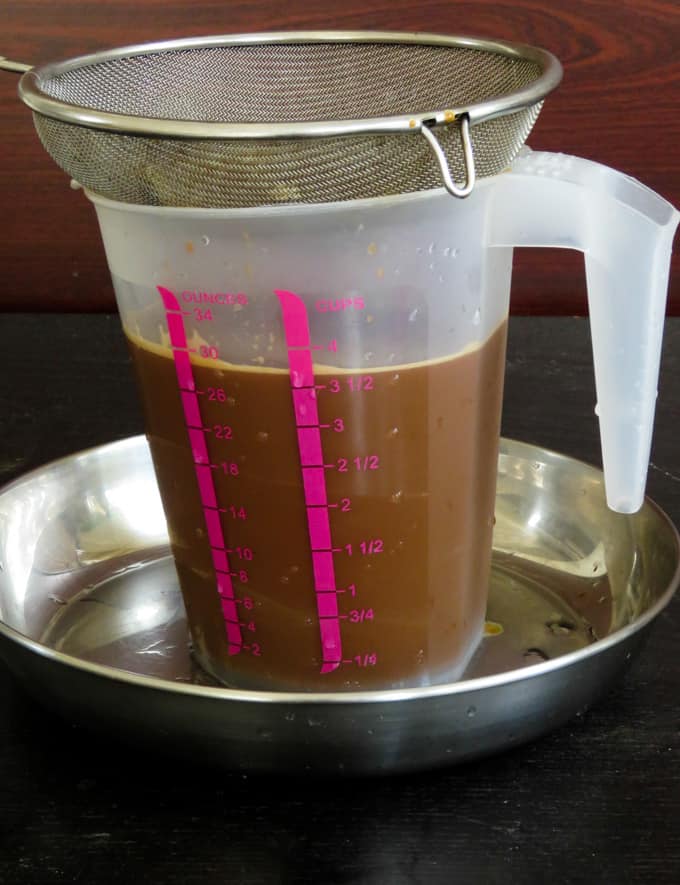
Strain the watalappam mix, into the jug.
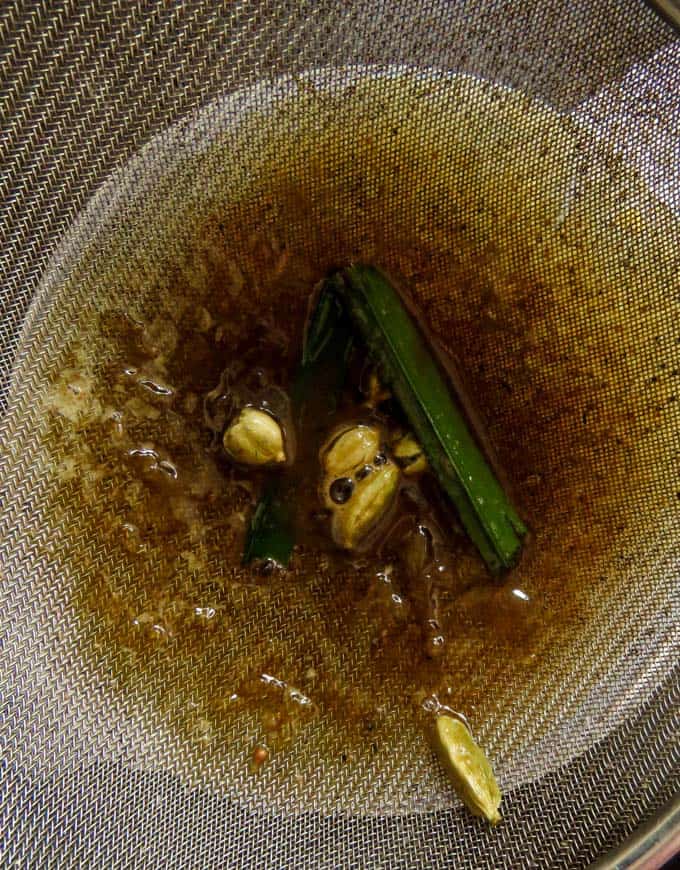
Pour the mixture into, aluminum bowls.
I am using bowls that are 4″ inches in diameter. I would highly recommend that you stick to this bowl size, even 5″ would do.
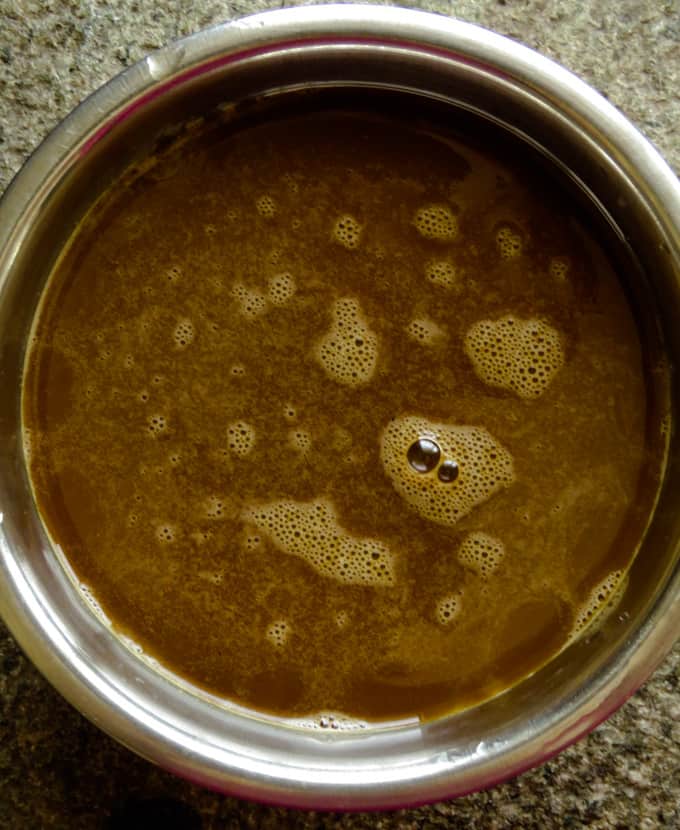
Steaming the watalappan
Place the pan you prepared for steaming over the stovetop. pour in water(an inch or two from the bottom of the pan).
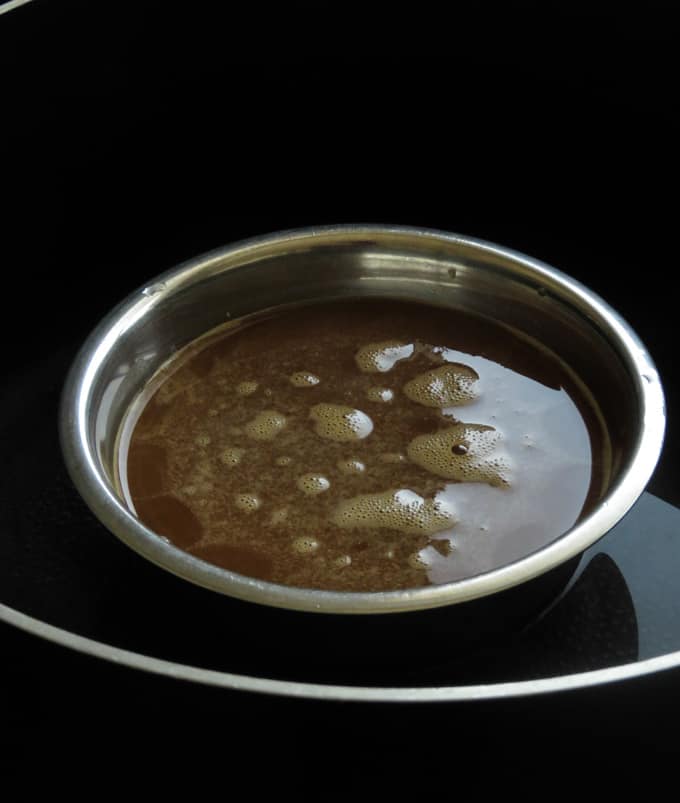
Cover with the lid and steam over a steady low-medium fire.
Depending on the pan you have used(refer to beginner’s notes in this regard)the time will be 30-45 minutes.
Reminder, if you should use a heavy-bottomed pan, the steaming time will extend to 45-1 hour.
Always make sure that there is no steam escaping from the pan as well.
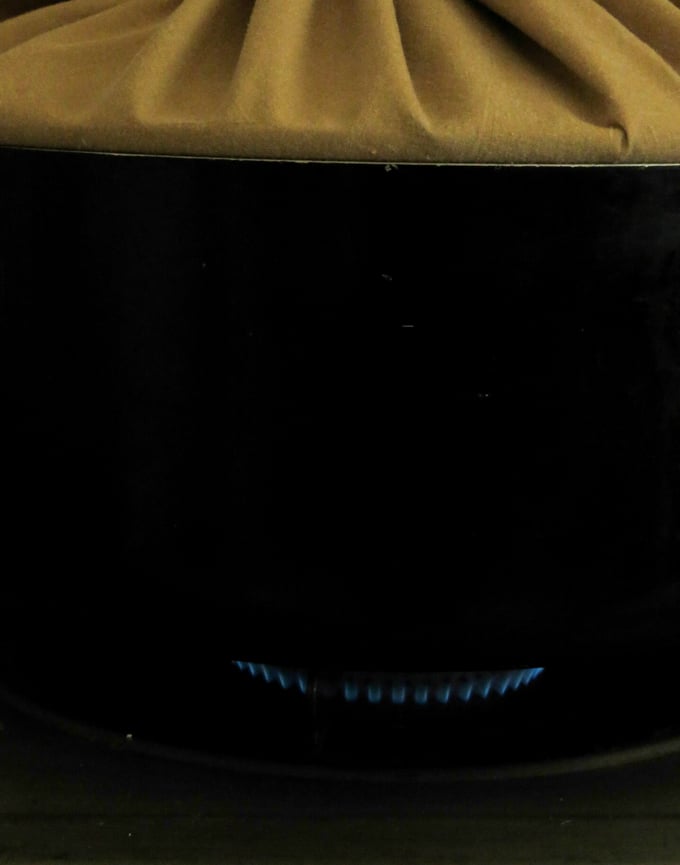
30-45 minutes later, switch off the fire, remove the lid and check if the watalappam is cooked through.
You will notice the top of the watalappam puffed up, this is normal and will gradually settle to give you that distinct look you are familiar with.
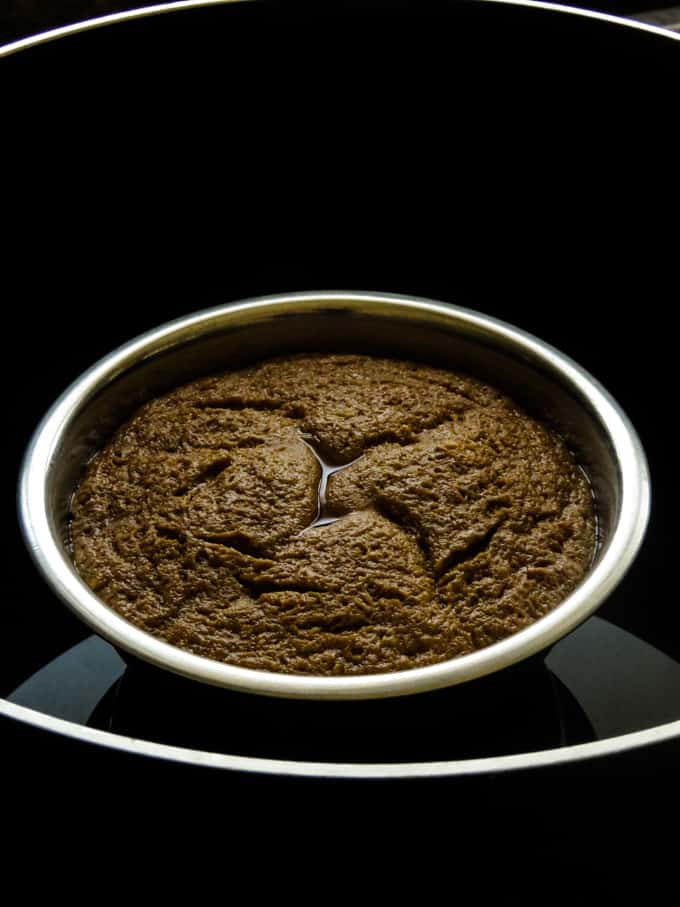
Insert a knife in the middle.
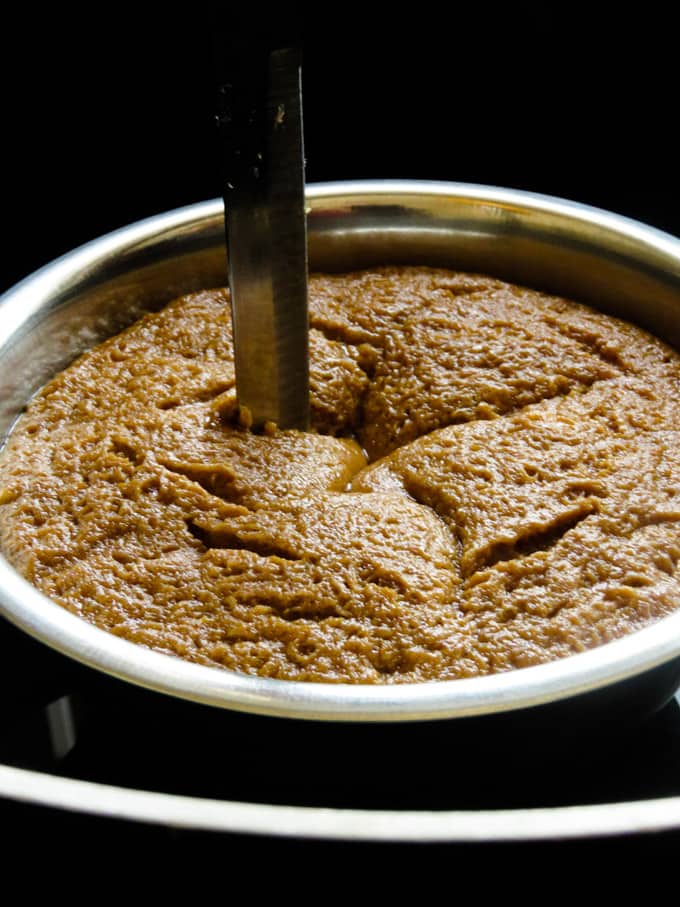
If the knife comes out clean, the watalappan is cooked through and you can remove the pan and let it cool.
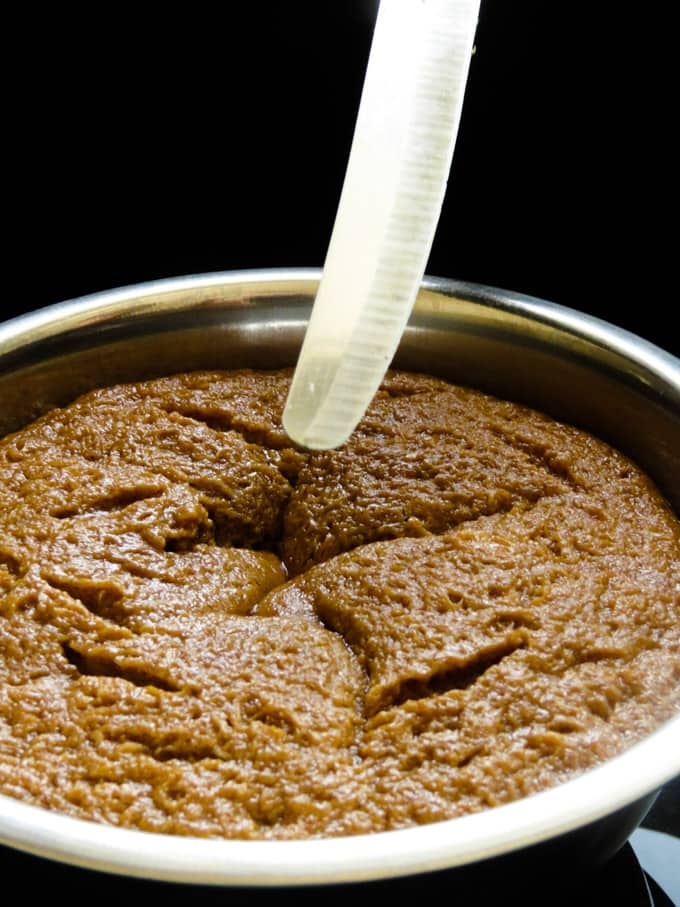
Continues steaming the remaining bowls the same way.
Always make sure there is enough water in the pan before starting with a new bowl to be steamed.
Below is the result of a steamed watalappan done right.
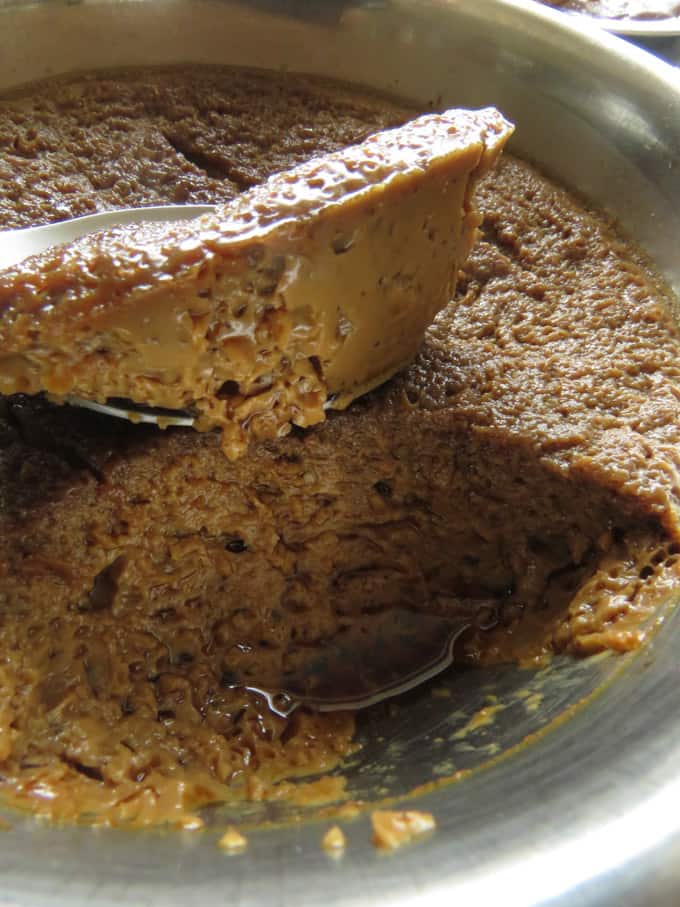
Other methods of making Watalappam and the results.
How to bake watalappam
Cover the bowl with foil and place it in a baking tray.
Preheat oven to 170c and then bake for 60 minutes at 170C.
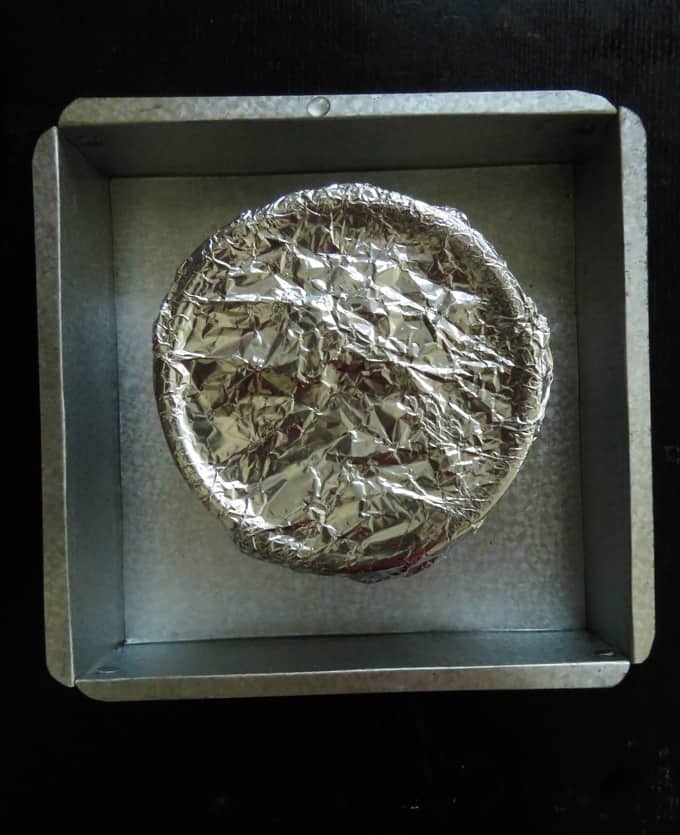
The below image shows you exactly how it looks when the watalappam is baked.
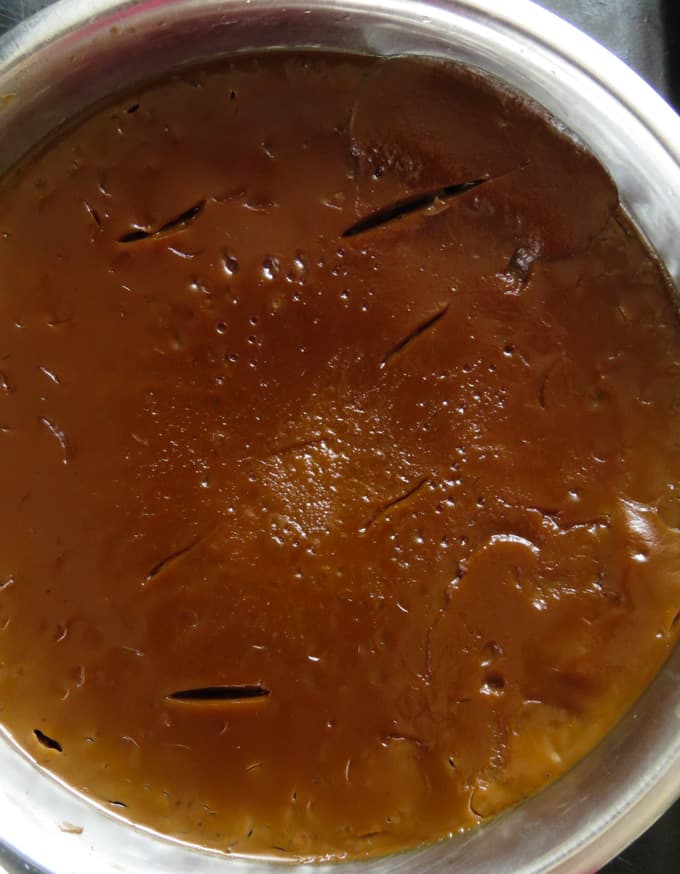
Once you cut into a baked watalappam, it looks like the following image.
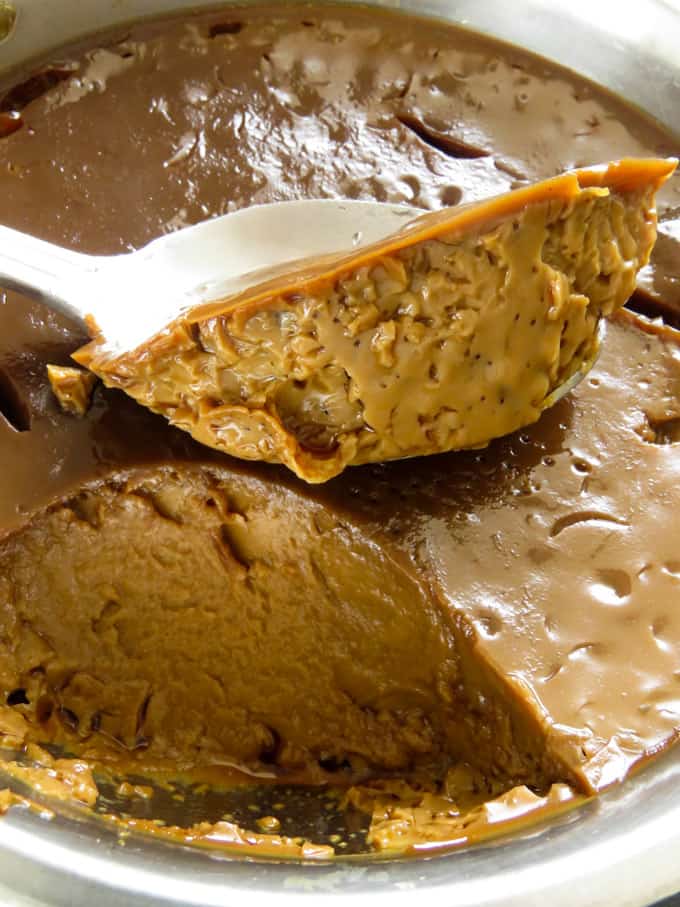
pressure cooker method watalappam
Although pressure cooking can reduce cooking time. the whole process can be slightly tricky especially if you are using a stovetop pressure cooker.
Cover the bowl with foil.
Pour just enough water to cover the bottom part of the bowl.
Gently place the bowl within the narrow confines of the pressure cooker.
Place and lock the lid and pressure cook for 7-8 minutes(about 3 whistles).
Release pressure and gently open the pressure cooker lid, allow steam to escape as much as you can, and remove the bowl from the pressure cooker.
Should you find the watalappan is not cooked through, cover the bowl again and pressure cook for another 3 minutes.
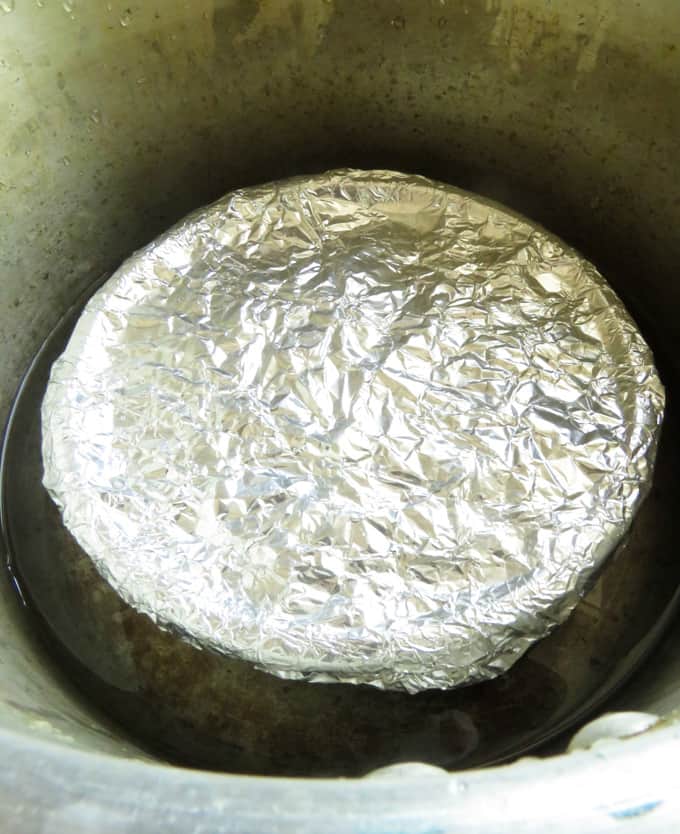
A pressure-cooked bowl of Jaggery pudding will look as below.
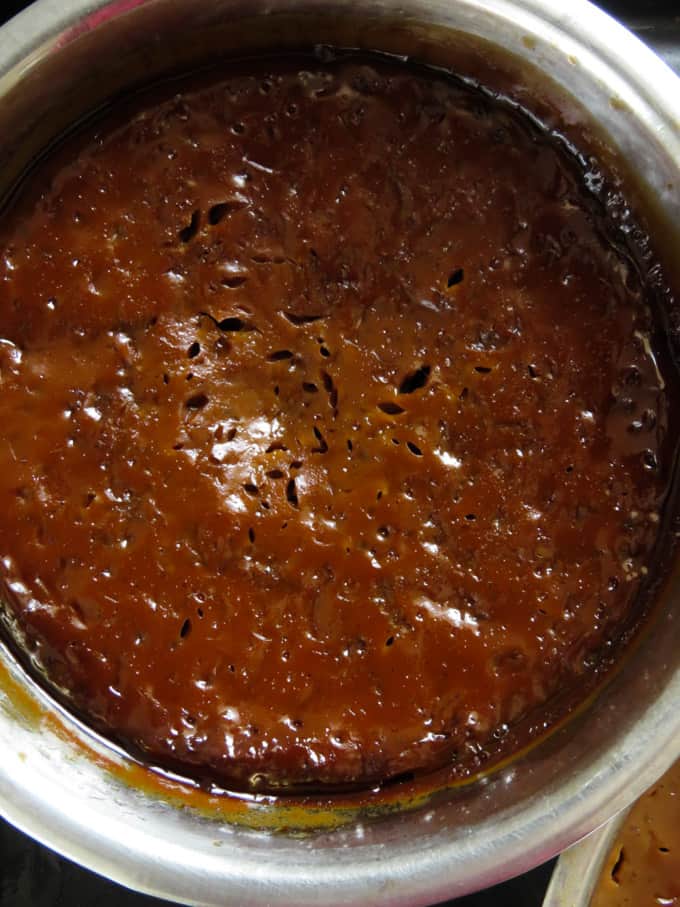
When you cut through it.
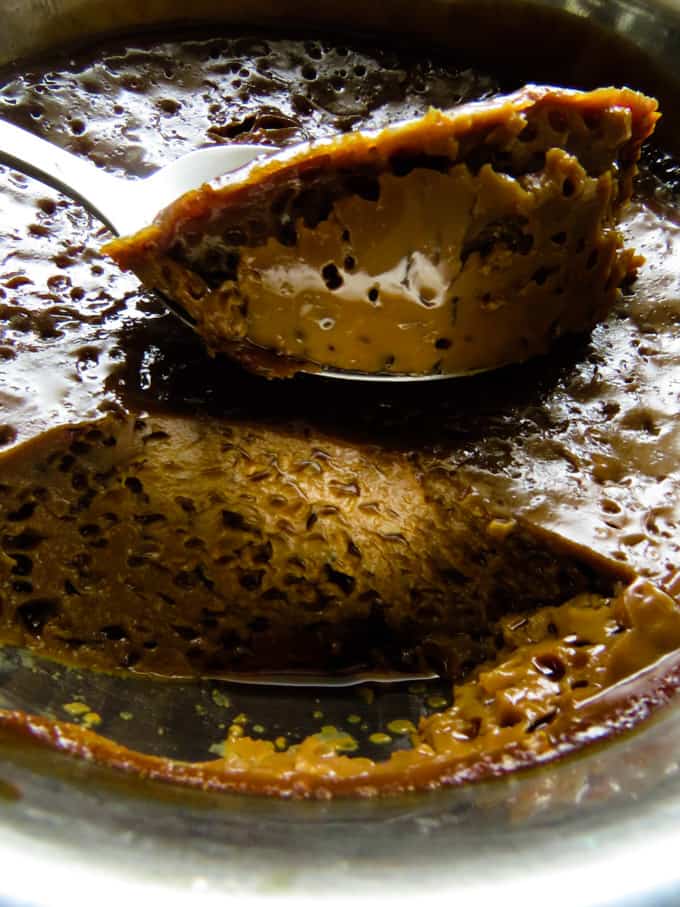
I will update making watalappam in a rice cooker when time permits.
Taste-testing the watalappam
From top to bottom.
1/ Pressure cooker method- creamy and tastes slightly like a creamy pudding. not able to taste the distinct nutmeg taste.
2/Baked-dense, caramelized sugar taste comes through. much creamier than the pressure-cooked method. not able to taste the nutmeg.
3/Steamed- light, has the honeycomb effect, doesn’t have the over-the-top creamy texture. can clearly taste the nutmeg and cardamom.
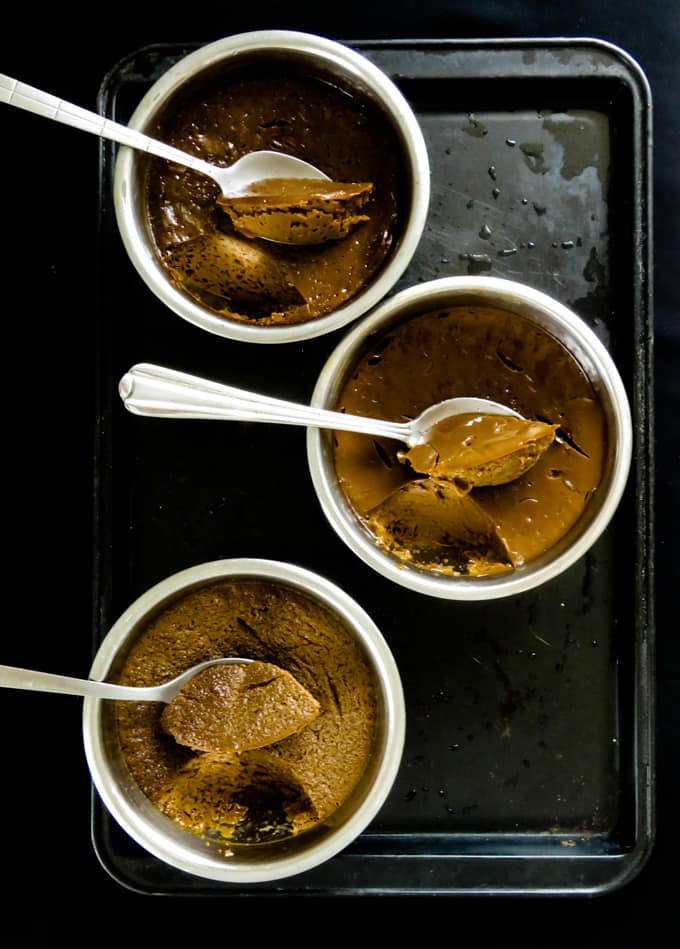
JOIN ME ON ISLANDSMILE YOUTUBE CHANNEL
visit the SEAFOOD BLOG.
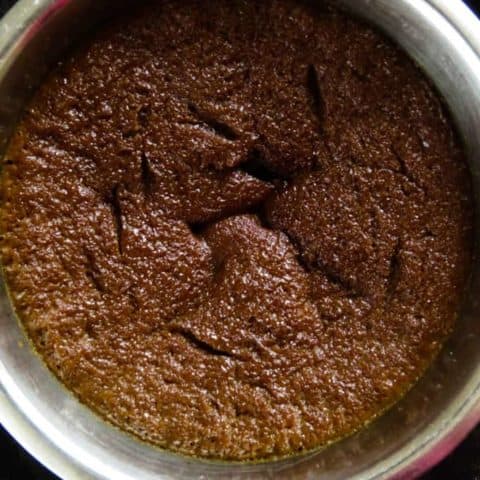
watalappan(coconut jaggery steamed pudding)
Here's your step-by-step guide on how to make a delicious bowl of Watalappan.
Ingredients
- Ingredients mentioned below use standard measuring cups and spoons.
- This recipe will give you 3 bowls of watalappam. the bowls used here are 4 to 5 in diameter.
- 10 eggs
- 500g Jaggery(broken into smaller pieces)
- 1/4 cup water
- 1/2 teaspoon of lime
- 500ml thick coconut milk(2 cups, this is not coconut cream)
- The fragrant whole spice mix
- 8 slightly bruised cardamom
- 1/2 teaspoon of grated nutmeg
- 2-inch Pandan leaf
Instructions
How this authentic Sri Lankan watalappam recipe is written.
Certain recipes need to be preserved as they are while finding new ways to adapt the recipe as well.
I have not written the watalappan recipe in a conventional way. This recipe includes,
The original and authentic watalappam recipe was made by my grandmother and mom.
I have also tested other ways of making this dessert and its outcome.
By this I mean, different cooking methods like steam which the original recipe calls for, and then baking and pressure cooking, other methods will be added as time permits.
I’ve also taste-tested them for you and noted down the differences in appearance and flavor, using the above methods of cooking.
At the time of writing this authentic watalappam recipe(April 2020). I have not substituted any ingredients to make a hybrid version.
By hybrid I mean, quick versions where there are substitute ingredients(condensed milk, pumpkin, store-bought jaggery syrup)but only experimented with the method of cooking.
I will do this in time and add it here as time permits. For now, let’s begin with the original recipe.
HOW TO MAKE WATALAPPAM.
Please make sure to read the recipe instructions carefully to avoid mistakes.
Before you begin making the watalappam, you first need to have a thin bottomed, deep cooking pot with a tight lid.
This pan should also be wide enough that, removing the steamed jaggery pudding can be done without burning yourself.
Prepare the steaming pan as mentioned in the recipe post above with images.
The lid needs to be covered with a thick cloth first.
The cloth surface that is going to be placed over the pan facing inside should be stretched and tight.
The covered lid helps to stop any steam from escaping while the watalappam cooks.
The cloth will also capture the condensation that builds on the lid which can spill and ruin the watalappam.
Once you’ve prepared the pan to steam the pudding it should look like the above image on the recipe post. set aside until used.
How to melt the Jaggery.
Use a medium-sized pan.
Add water(1/4 cup) and Jaggery(500g). The melting process would be easier if you can break the hard jaggery into smaller pieces.
Avoid adding more water as you want the Jaggery to be really thick, giving you somewhat a heavy and dark syrup.
Maintaining low heat, melt the jaggery while stirring it every few minutes, make sure the thick syrup does not stick to the pan by keeping the flame as low as possible.
Once the jaggery melts, remove it from the stove and set it aside to cool.
Jaggery tends to harden as it cools, to avoid this add lime juice(1 tsp)and stir a few times.
Have your whole spices ready( 8 cardamom-bruised, 1/2 tsp grated nutmeg, 2-inch pandan leaf).
If you are unable to find the following spices use Vanilla essence(1 teaspoon).
But please do try using the whole spices and experience the taste difference at least once.
How to make the watalappan mixture.
Break the eggs(10) one by one into a small bowl to check freshness and then add them into a medium-sized bowl or pan.
Add the whole spices and pandan leaf to the egg mixture.
Whisk lightly until the egg yolks are broken for 3-5 minutes.
Avoid whisking vigorously. keep your movements light by making sure your whisk is not hitting the bottom of the egg mixture bowl.
If you are making a large batch of watalappam, this can be done with a handheld mixer.
Once you have beaten the eggs, set this aside for a few seconds and go back to your COOL melted jaggery.
Stir the Jaggery a little, make sure the syrup is completely cool.
And only then add the egg mixture to the Jaggery syrup.
Stir to combine the Jaggery with the whisked eggs.
Finally, add the thick coconut milk(500g=roughly 2 cups of liquid) to the egg and jaggery syrup.
Use a whisk or fork to lightly beat the watalappam mixture for 3-5 minutes(I did it for 5 minutes).
Again keep your movements light and avoid the whisk or fork hitting the bottom of the pan.
Have a large jug and strainer ready. strain the watalappam mix, into the jug.
Pour the mixture into, aluminum bowls.
I am using bowls that are 4″ inches in diameter. I would highly recommend that you stick to this bowl size, even 5″ would do.
Place the pan you prepared for steaming over the stovetop. pour in water(an inch or two from the bottom of the pan).
Cover with the lid and steam over steady low-medium fire.
Depending on the pan you have used(refer to beginner’s notes in this regard)the time will be 30-45 minutes
Reminder, if you should use a heavy-bottomed pan, the steaming time will extend to 45-1 hour.
Always make sure that there is no steam escaping from the pan as well.
30-45 minutes later, switch off the fire, remove the lid and check if the watalappam is cooked through.
You will notice the top of the watalappam puffed up, this is normal and will gradually settle to give you that distinct look you are familiar with.
Insert a knife in the middle.
If the knife comes out clean, the watalappam is cooked through and you can remove it from the pan and let it cool.
Continues steaming the remaining bowls the same way.
Always make sure there is enough water in the pan before starting with a new bowl to be steamed.
Below is the result of a steamed watalappan done right.
Other methods of making Watalappam and the results.
How to bake watalappam.
Cover the bowl with foil and place it in a baking tray.
Preheat oven to 170c and then bake for 60 minutes at 170C.
How to pressure cook watalappam.
Although pressure cooking can reduce cooking time. the whole process can be slightly tricky especially if you are using a stovetop pressure cooker.
Cover the bowl with foil.
Pour just enough water to cover the bottom part of the bowl.
Gently place the bowl within the narrow confines of the pressure cooker.
Place and lock the lid and pressure cook for 7-8 minutes(about 3 whistles).
Release pressure and gently open the pressure cooker lid, allow steam to escape as much as you can, and remove the bowl from the pressure cooker.
Should you find the watalappan is not cooked through, cover the bowl again and pressure cook for another 3 minutes.
I will update making watalappam in a rice cooker when time permits.
Taste-testing the watalappam.
From top to bottom
1/ Pressure cooker method- creamy and tastes slightly like a creamy pudding. not able to taste the distinct nutmeg taste.
2/Baked-dense, caramelized sugar taste comes through. much creamier than the pressure-cooked method. not able to taste the nutmeg.
3/Steamed- light, has the honeycomb effect, doesn't have the over-the-top creamy texture. can clearly taste the nutmeg and cardamom.
Recommended Products
As an Amazon Associate and member of other affiliate programs, I earn from qualifying purchases.
-
 Duralex LYS Mixing Bowl Set, 10 Piece, clear
Duralex LYS Mixing Bowl Set, 10 Piece, clear -
 OXO Good Grips 11-Inch Balloon Whisk
OXO Good Grips 11-Inch Balloon Whisk -
 MOBUTA Stainless Steel Stockpot with Lid, 5-Quart Stock pot Stew Pot Casserole Soup Pot for Induction Stovetop, Tri-Ply Heavy Bottomed Base with Scale Mark & Tempered Glass Lid, Dishwasher & Oven Safe
MOBUTA Stainless Steel Stockpot with Lid, 5-Quart Stock pot Stew Pot Casserole Soup Pot for Induction Stovetop, Tri-Ply Heavy Bottomed Base with Scale Mark & Tempered Glass Lid, Dishwasher & Oven Safe -
 ZESPROKA Stainless Steel Fine Mesh Strainers Set of 3–Large, Medium & Small Sifters with Comfortable & Non Slip Handles – Ideal for Pasta, Rice, Tea, Spaghetti, Quinoa, Baking
ZESPROKA Stainless Steel Fine Mesh Strainers Set of 3–Large, Medium & Small Sifters with Comfortable & Non Slip Handles – Ideal for Pasta, Rice, Tea, Spaghetti, Quinoa, Baking -
 Rubbermaid Commercial Products Bouncer Measuring Cup, 4-Quart, Clear, FG321800CLR
Rubbermaid Commercial Products Bouncer Measuring Cup, 4-Quart, Clear, FG321800CLR -
 Amazon Brand - Happy Belly Nutmeg, Ground, 3.25 Ounces
Amazon Brand - Happy Belly Nutmeg, Ground, 3.25 Ounces -
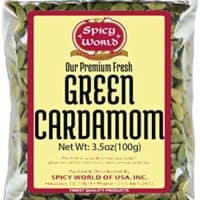 Spicy World Green Cardamom Pods, 3.5 Ounce
Spicy World Green Cardamom Pods, 3.5 Ounce -
 Jiva Organic Jaggery Whole (Gur, Panela) 2.2 LB (1000 g) - Raw Wholesome Sugar / Organic Sugarcane
Jiva Organic Jaggery Whole (Gur, Panela) 2.2 LB (1000 g) - Raw Wholesome Sugar / Organic Sugarcane -
 SRR All Natural Palm Sugar Jaggery - 1.200 to 1.450 kg - 20 discs
SRR All Natural Palm Sugar Jaggery - 1.200 to 1.450 kg - 20 discs -
 Pandanus Leaves, Dried | Aromatic and Delicious Blade-like Leaf | Popular Ingredient in Southeast Asian and South Asian Delicacies 0.5 oz.
Pandanus Leaves, Dried | Aromatic and Delicious Blade-like Leaf | Popular Ingredient in Southeast Asian and South Asian Delicacies 0.5 oz. -
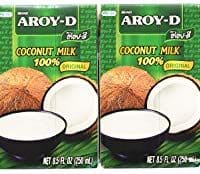 Aroy-d Coconut Milk 100% Original Net 8.5 Oz.(pack of 12)
Aroy-d Coconut Milk 100% Original Net 8.5 Oz.(pack of 12) -
 AOZITA 24 Pcs Glass Spice Jars/Bottles - 4oz Empty Square Spice Containers with Spice Labels - Shaker Lids and Airtight Metal Caps - Silicone Collapsible Funnel Included
AOZITA 24 Pcs Glass Spice Jars/Bottles - 4oz Empty Square Spice Containers with Spice Labels - Shaker Lids and Airtight Metal Caps - Silicone Collapsible Funnel Included
Nutrition Information:
Yield: 1 Serving Size: 1Amount Per Serving: Calories: 3656Total Fat: 156gSaturated Fat: 111gTrans Fat: 0gUnsaturated Fat: 34gCholesterol: 1860mgSodium: 920mgCarbohydrates: 520gFiber: 5gSugar: 487gProtein: 75g
Nutritional information on islandsmile is provided as a courtesy. We cannot guarantee the accuracy of the nutritional information given for any recipe on the site. these figures should only be considered as estimates.
Each recipe on this blog has been written with great care and love to the best of my ability with you in mind.
It’s free and on the blog, for you to try anytime.
All I ask is that you do not save it on any apps, recipe boxes or online groups which will affect me as a food blogger and the growth of this blog.
I would appreciate it if you only share the link rather than the full recipe.
Avid Fan of your Blog
Saturday 29th of March 2025
I always found watalappan to be such a daunting task for so many reasons, but ever since I came across your recipe a few years ago, it has been an absolute breeze! I’ve even started enjoying the process, and every time I make it, I find myself making so much duaa for you and your family. Truly grateful for this gem of a recipe!
jehan
Saturday 29th of March 2025
Hi, Oh thank you for this gem of a comment, your duas especially for me and my family is so much appreciated. the hope is to preserve the recipe for the future for my family as well as for everyone out there. Best regards and love. J